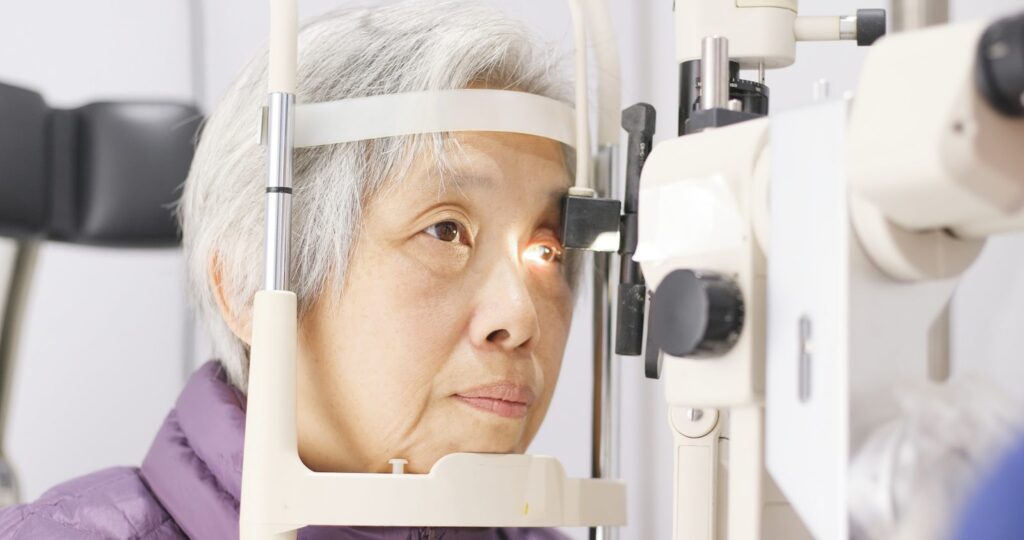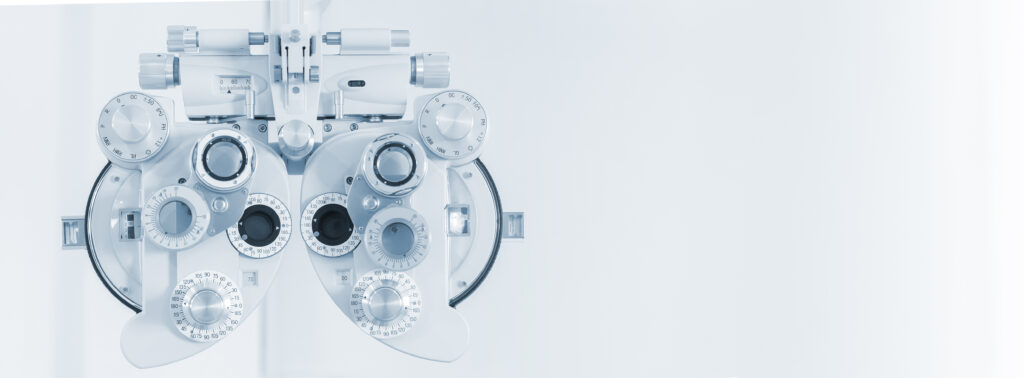
Eyecare & Aesthetic, Prima Medical Center Saigon
What is a refraction test?
14 August, 2024
Prima Saigon Eye Hospital: A refraction test is usually given as part of a routine eye examination. It may also be called a vision test. This test tells your eye doctor exactly what prescription you need in your glasses or contact lenses.

People with glaucoma need to have their eyes examined to determine appropriate treatment methods
Normally, a value of 20/20 is considered to be optimum, or perfect vision. Individuals who have 20/20 vision are able to read letters that are 3/8 of an inch tall from 20 feet away.
If you don’t have 20/20 vision, you have what is called a refractive error. A refractive error means that the light is not bending properly when it passes through the lens of your eye. The refraction test will tell your doctor what prescription lens you should use in order to have 20/20 vision.
Why is this test used?
This test tells your doctor if you need prescription lenses, as well as what prescription lens you need to see properly. The results of the test are used to diagnose the following conditions:
- Astigmatism, a refractive problem with the eye related to the shape of the lens, which causes blurry vision
- Hyperopia, which is also known as farsightedness
- Myopia, which is also known as nearsightedness
- Presbyopia, a condition related to aging that causes lens of the eye to have trouble focusing
The results of the test can help diagnose the following conditions:
- Macular degeneration, a condition related to aging that affects your sharp central vision
- Retinal vessel occlusion, a condition that causes the small blood vessels near the retina to be blocked
- Retinitis pigmentosa, a rare genetic condition that damages the retina
- Retinal detachment, when the retina detaches from the rest of the eye
Who should be tested?
Eye examining with Computerized Refractor
Healthy adults under age 60 who aren’t experiencing vision problems should have a refraction test every two years. Children should have a refraction test every one to two years, starting at no later than 3 years of age.
If you currently wear prescription glasses or contact lenses, you should have a refraction test every one to two years.
This will allow your doctor to figure out what prescription is necessary as your eyes change. If you’re having problems with your vision between exams, you should see your eye doctor for another refraction test.

Prima Saigon Eye Hospital: If you currently wear prescription glasses or contact lenses, you should have a refraction test every one to two years.
If you have diabetes you should have an eye examination every year. A number of eye conditions are associated with diabetes, such as diabetic retinopathy and glaucoma. According to the American Diabetes Association, people with diabetes are at a greater risk for blindness than other Americans.
If you’re over 60 or have a family history of glaucoma you should also have a refraction test every year. Glaucoma occurs when pressure builds up in the eye, damaging the retina and the optic nerve. Regular exams will help your eye doctor screen for glaucoma and other eye conditions associated with aging and, if possible, treat them early.
What happens during the test?
Eye examining with Phoroptor machine
Your doctor will first assess how light bends as it moves through your cornea and the lens of your eyes. This test will help your eye doctor determine whether you need corrective lenses and, if so, what type of prescription you need. Your doctor may use a computerized refractor for this part of the test, or they may simply shine a light into your eyes.
In the computerized test, you look through a machine that measures the amount of light reflected by your retina.
Your doctor may also do this test without the help of a machine. In this case, they will shine a light into each of your eyes and look at the amount of light that is bouncing off your retina to measure your refractive score.
Afterward, your doctor will determine exactly what prescription you need. For this part of the test, you’ll be seated in front of a piece of equipment called a Phoroptor. This looks like a large mask with holes for your eyes to look through. On a wall about 20 feet in front of you will be a chart of letters. For children who cannot yet identify letters, your doctor will use a chart with small pictures of common items.
Eye examining with Eye Chart
Testing one eye at a time, your eye doctor will ask you to read the smallest row of letters that you can see. Your doctor will change out the lenses on the Phoroptor, asking you each time which lens is clearer. If you’re unsure, ask your doctor to repeat the choices.
When your eye doctor is finished testing one eye, they will repeat the procedure for the other eye. Finally, they will come up with the combination that comes closest to giving you 20/20 vision.
Everyone needs a refraction test
Regular eye examinations are crucial for maintaining the health of your vision. They’re a routine part of an eye doctor visit and require no preparation on your part. They can help your doctor diagnose and treat conditions such as glaucoma and determine the need for corrective lenses, among other things.
Healthy adults should have a refraction test every two years, while children need them every one or two years beginning at age 3.
Dr QUYNH Ha, Senior Consultant (Refractive & Lasik)
Our renowned Refractive Care Team:
- Dr THAO Vo, Chief Medical Officer , Prima Saigon Eye Hospital
- Dr QUYNH Ha, Senior Consultant (Refractive & Lasik)
If you need an eye assessment, please have a visit to Prima Saigon Eye Hospital
- Address: 27 Ky Dong St, District 3, HCMC
- Website: https://primahealth.vn/en/
- Business Hours: 07:30 – 17:00 from Monday – Saturday
- HOTLINE: 0919-209-039 or 1900 – 9115
Prima Saigon Eye Hospital recommends that clients should reserve their intended consultation at least three days before their visit for convenience and less waiting time.
Prima Saigon Eye Hospital: A refraction test is usually given as part of a routine eye examination. It may also be called a vision test. This test tells your eye doctor exactly what prescription you need in your glasses or contact lenses.

People with glaucoma need to have their eyes examined to determine appropriate treatment methods
Normally, a value of 20/20 is considered to be optimum, or perfect vision. Individuals who have 20/20 vision are able to read letters that are 3/8 of an inch tall from 20 feet away.
If you don’t have 20/20 vision, you have what is called a refractive error. A refractive error means that the light is not bending properly when it passes through the lens of your eye. The refraction test will tell your doctor what prescription lens you should use in order to have 20/20 vision.
Why is this test used?
This test tells your doctor if you need prescription lenses, as well as what prescription lens you need to see properly. The results of the test are used to diagnose the following conditions:
- Astigmatism, a refractive problem with the eye related to the shape of the lens, which causes blurry vision
- Hyperopia, which is also known as farsightedness
- Myopia, which is also known as nearsightedness
- Presbyopia, a condition related to aging that causes lens of the eye to have trouble focusing
The results of the test can help diagnose the following conditions:
- Macular degeneration, a condition related to aging that affects your sharp central vision
- Retinal vessel occlusion, a condition that causes the small blood vessels near the retina to be blocked
- Retinitis pigmentosa, a rare genetic condition that damages the retina
- Retinal detachment, when the retina detaches from the rest of the eye
Who should be tested?
Eye examining with Computerized Refractor
Healthy adults under age 60 who aren’t experiencing vision problems should have a refraction test every two years. Children should have a refraction test every one to two years, starting at no later than 3 years of age.
If you currently wear prescription glasses or contact lenses, you should have a refraction test every one to two years.
This will allow your doctor to figure out what prescription is necessary as your eyes change. If you’re having problems with your vision between exams, you should see your eye doctor for another refraction test.

Prima Saigon Eye Hospital: If you currently wear prescription glasses or contact lenses, you should have a refraction test every one to two years.
If you have diabetes you should have an eye examination every year. A number of eye conditions are associated with diabetes, such as diabetic retinopathy and glaucoma. According to the American Diabetes Association, people with diabetes are at a greater risk for blindness than other Americans.
If you’re over 60 or have a family history of glaucoma you should also have a refraction test every year. Glaucoma occurs when pressure builds up in the eye, damaging the retina and the optic nerve. Regular exams will help your eye doctor screen for glaucoma and other eye conditions associated with aging and, if possible, treat them early.
What happens during the test?
Eye examining with Phoroptor machine
Your doctor will first assess how light bends as it moves through your cornea and the lens of your eyes. This test will help your eye doctor determine whether you need corrective lenses and, if so, what type of prescription you need. Your doctor may use a computerized refractor for this part of the test, or they may simply shine a light into your eyes.
In the computerized test, you look through a machine that measures the amount of light reflected by your retina.
Your doctor may also do this test without the help of a machine. In this case, they will shine a light into each of your eyes and look at the amount of light that is bouncing off your retina to measure your refractive score.
Afterward, your doctor will determine exactly what prescription you need. For this part of the test, you’ll be seated in front of a piece of equipment called a Phoroptor. This looks like a large mask with holes for your eyes to look through. On a wall about 20 feet in front of you will be a chart of letters. For children who cannot yet identify letters, your doctor will use a chart with small pictures of common items.
Eye examining with Eye Chart
Testing one eye at a time, your eye doctor will ask you to read the smallest row of letters that you can see. Your doctor will change out the lenses on the Phoroptor, asking you each time which lens is clearer. If you’re unsure, ask your doctor to repeat the choices.
When your eye doctor is finished testing one eye, they will repeat the procedure for the other eye. Finally, they will come up with the combination that comes closest to giving you 20/20 vision.
Everyone needs a refraction test
Regular eye examinations are crucial for maintaining the health of your vision. They’re a routine part of an eye doctor visit and require no preparation on your part. They can help your doctor diagnose and treat conditions such as glaucoma and determine the need for corrective lenses, among other things.
Healthy adults should have a refraction test every two years, while children need them every one or two years beginning at age 3.
Dr QUYNH Ha, Senior Consultant (Refractive & Lasik)
Our renowned Refractive Care Team:
- Dr THAO Vo, Chief Medical Officer , Prima Saigon Eye Hospital
- Dr QUYNH Ha, Senior Consultant (Refractive & Lasik)
If you need an eye assessment, please have a visit to Prima Saigon Eye Hospital
- Address: 27 Ky Dong St, District 3, HCMC
- Website: https://primahealth.vn/en/
- Business Hours: 07:30 – 17:00 from Monday – Saturday
- HOTLINE: 0919-209-039 or 1900 – 9115
Prima Saigon Eye Hospital recommends that clients should reserve their intended consultation at least three days before their visit for convenience and less waiting time.



